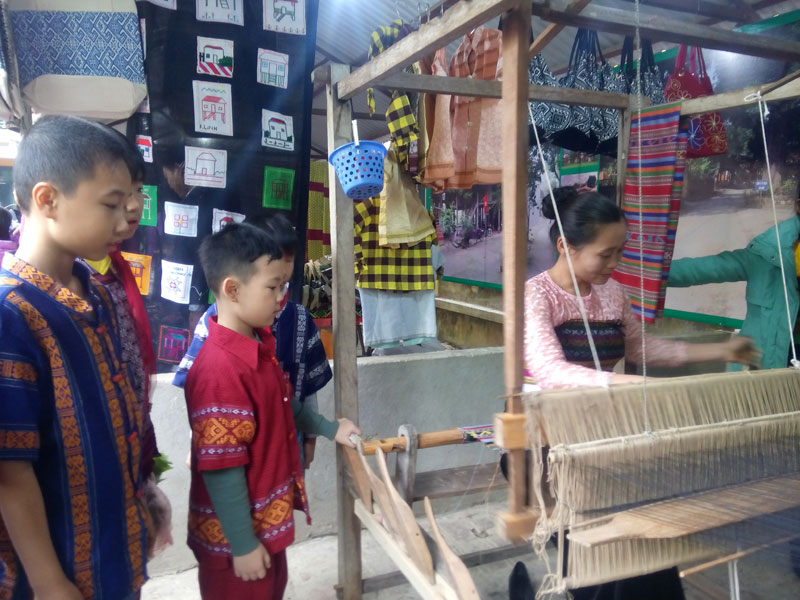
(HBO) - To contribute to preserving and promoting cultural identities of ethnic groups in Mai Chau, at the beginning of the school year 2017 - 2018, Mai Chau Town Primary School launched a movement that students attending classes will wear ethnic costume at least one day per week in a bid to help them deeply understand, respect and be proud of traditional beauty of their ethnicity.

Pupils of Mai Chau Town Primary School had a
chance to experience community tourism, which contributes to educating children
to appreciate the value of ethnic cultural identity.
In this year, there are 303 Thai-ethnic
students, 198 Kinh (Viet)-ethnic students, 18 Mong-ethnic students, 15
Muong-ethnic students and others such as Dao and Tay ones.
Based on that, the school encourages children
to wear their ethnic traditional costumes. This does not only help them
remember the features of how to sew, how to embroider each pattern and motif,
and understand the meaning that the older generation impart to each set of
costumes, but also create a colorful picture of ethnic communities in the highland
districts (Mai Chau).
Bao Ngoc Ha, a student of class 5A1 in Mai
Chau Town Primary School, told: "I’m a Thai-ethnic student. At the beginning of
year, my mother sewed a Thai girl ethnic costume. When I was wearing to attend
the class, I felt very proud of my ethnicity. Moreover, after the studying time
in classes, I usually help my mother embroider a lot of patterns in order to
sew on pictures, handbags, scarfs and dressed which are advertised for
tourists.
Not only encouraging to wear ethnic costumes
as uniforms in the school, but the school also organizes folk songs and
traditional games at the time of outdoor activities or in the break time in a
purpose of that students can relax after stressful days of classes. These
activities are favorited by many students and teachers, and the atmosphere in
school also begins exciting and bustling. Therefore, every day for students to
go to school is a happy day and the quality of study is also improved
significantly.
Ms. Thanh Nhan Mai, a teacher managing youth
union as well as a trade union chairwoman of school, said that perceiving and
educating about ethnic traditions for the young generations are necessary to
conserve and maintain cultural identities of ethnic groups in the future.
Furthermore, students can discovery more features which are familiar to daily
life, therefore, every edge of classes or traditional rooms of school are
decorated carefully by students and teachers. They also collect many stuffs to
make geometric models for everyone to visit, learn and help them more love and
be proud of local cultures.
Hoa Binh province has carried out multiple programmes and initiatives to revive its cultural heritage which has gradually fallen into oblivion through the ebbs and flows of history.
The most prominent and defining feature in the prehistoric era of Hoa Binh is the Hoa Binh Culture. The Culture was first discovered in Hoa Binh. The significant prehistoric culture represents not only Vietnam but also Southeast Asia and southern China. Through excavations of cave sites in the limestone regions of Hoa Binh, French archaeologist M. Colani introduced the world to a "Stone Age in Hoa Binh province – Northern Vietnam" in 1927. On January 30, 1932, the First Congress of Far Eastern Prehistorians, held in Hanoi, officially recognised the Hoa Binh Culture.
Known as the "Land of Epic History”, Hoa Binh province, the gateway to Vietnam’s northwest, boasts a strategic location and a unique cultural tapestry woven by its ethnic minority communities.
The People's Committee of Luong Son District recently held a ceremony to receive the certificate recognizing Sau Communal House in Thanh Cao Commune as a provincial-level historical and cultural site.
Recognising the importance of cultural heritage preservation in protecting and promoting the value system of Vietnamese culture, and serving socio-economic development in the new period, Party committees and local administrations in Hoa Binh province have identified it as a key task in the cultural development strategy. The province has been making efforts in mobilising resources, creating consensus among people and engaging ethnic communities in preserving and promoting cultural identity.
Hoa Binh province has captured growing attention both domestically and internationally for its distinctive cultural heritage and rich history. Most notably, it has been renowned for its famous Hoa Binh culture, considered the cradle of ancient Vietnamese civilisation. Looking ahead to significant milestones in 2025 and the 140th anniversary of province establishment in 2026, Hoa Binh Newspaper presents a comprehensive overview of the province's development across economic, social, cultural, tourism, and security domains.



